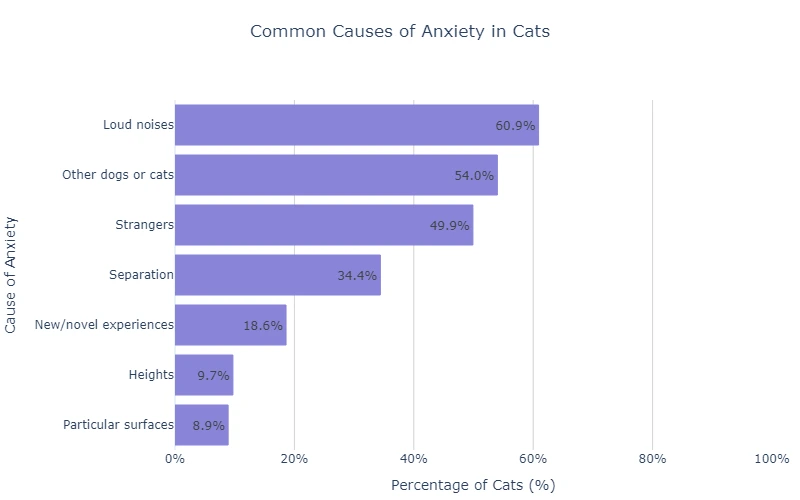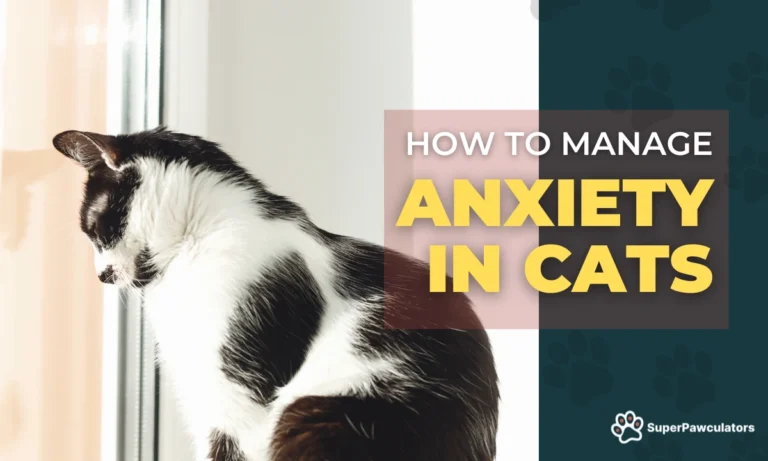Is your cat acting more nervous than usual? Maybe they’re hiding under the bed more often, getting snippy, or just seem on edge? You’re not alone. Many cat parents worry when their furry friend shows signs of stress – research indicates that approximately 20-25% of cats experience anxiety-related issues.
Helping your cat feel more relaxed isn’t about quick solutions. It’s like creating a cozy, safe space where they can be themselves again. If you’re looking to help your anxious cat find their inner peace, let’s walk through some tried-and-true ways to bring back their confidence and calm.
Understanding Cat Anxiety
Recognizing anxiety in cats requires careful observation, as felines cannot verbally express their distress. Instead, they communicate through various behavioral and physical signs that pet owners need to identify and understand.
Common Triggers of Cat Anxiety:
- Environmental Changes: Moving to a new home, rearranging furniture, or even changing their litter box location
- Social Changes: New pets, family members, or visitors
- Loud Noises: Thunderstorms, construction work, or household appliances
- Schedule Disruptions: Changes in feeding times or their human’s work schedule
- Past Trauma: Previous negative experiences or lack of early socialization

Signs of Feline Anxiety:
Physical Signs:
- Excessive grooming (leading to bald patches)
- Changes in appetite (eating too much or too little)
- Digestive issues
- Increased vocalization
- Trembling or shaking
Behavioral Signs:
- Hiding for extended periods
- Aggressive behavior (hissing, scratching, biting)
- Inappropriate elimination outside the litter box
- Excessive clinginess or withdrawal
- Destructive behavior
- Severity Levels of Cat Anxiety:
| Severity Level | Signs | When to Seek Help |
|---|---|---|
| Mild | Occasional hiding, slight changes in behavior | Monitor and implement home solutions |
| Moderate | Regular anxiety signs, affecting daily routine | Consider consulting a vet |
| Severe | Constant distress, self-harm, aggressive behavior | Immediate veterinary attention needed |
Now that you know the signs of an anxious cat, let’s look at ways to help them feel better. There are many simple steps you can take at home to make your cat feel safe and calm. Starting with creating a comfortable space and moving on to getting help from experts, these solutions can help your cat feel more relaxed and happy.
1. Creating a Safe Environment
Creating a secure environment plays a crucial role in managing feline anxiety. Cats thrive in spaces that offer both security and freedom of movement, allowing them to exhibit natural behaviors while feeling protected.
Essential Elements of a Cat-Safe Space:
Dedicated Safe Zones
- Elevated Perches
- Install cat shelves or window perches at different heights
- Position furniture to create natural climbing opportunities
- Ensure all perches are sturdy and easily accessible
Strategic Hiding Spots
- Provide covered beds or cat caves
- Create cozy nooks under furniture
- Set up cardboard boxes in quiet corners
Environmental Optimization
- Maintain consistent room temperature (68-72°F)
- Ensure access to both sunlit and shaded areas
- Use soft, natural lighting when possible
- Minimize sudden noises
- Consider white noise machines in busy households
- Keep TV and music volumes moderate
Key Considerations:
Territory Management
- Separate resources (food, water, litter boxes) from busy areas
- Follow the “1+1 rule”: one litter box per cat, plus one extra
- Place resources in different locations to prevent territorial stress
Multi-Cat Households
- Provide multiple escape routes
- Ensure each cat has their own safe space
- Create separate feeding stations to reduce competition
If you’re planning to add a new cat to your household, check out our detailed guide on How to Introduce a New Cat to Your Home. This will help make the transition smoother and reduce anxiety for all cats involved.
2. Natural Calming Methods
Natural approaches to calming an anxious cat can be highly effective when implemented correctly and consistently. These methods focus on working with the cat’s natural instincts and behaviors to reduce stress levels.
Physical Comfort Techniques
Understanding proper petting is crucial for calming an anxious cat. The most effective areas for soothing touch include the base of the chin, behind the ears, and cheeks. Always start slowly and watch for signs of acceptance. Some cats may enjoy gentle strokes at the base of their tail, but avoid sensitive areas like the belly and paws unless the cat clearly invites such interaction.
Key Areas to Monitor During Petting:
- Positive Signs: Purring, slow blinking, relaxed posture
- Warning Signs: Tail twitching, skin rippling, flattened ears
Gentle massage can provide significant comfort to anxious cats. Start with light, circular motions for just 2-3 minutes, gradually increasing duration as your cat becomes more comfortable. For some cats, veterinary-approved anxiety wraps can provide additional comfort, though these should only be used for short periods of 30-45 minutes with careful monitoring.
3. Behavioral Training Approaches
Behavioral training for anxious cats requires patience, consistency, and a gentle approach. Understanding that cats respond best to positive reinforcement is key to successful anxiety management through training.
Positive Reinforcement Techniques
The foundation of behavioral modification lies in creating positive associations. This approach helps cats build confidence and reduces anxiety in challenging situations. Rewards should be immediate and highly valued by the cat—whether it’s special treats, favorite toys, or praise.
Essential Training Components:
- Timing: Reward within 3 seconds of desired behavior
- Consistency: Use the same cues and rewards
- Patience: Progress at the cat’s own pace
Desensitization Process
Desensitization involves gradually exposing cats to anxiety triggers at a level they can tolerate. For example, if a cat fears visitors, the process might begin with having someone sit quietly in an adjacent room, gradually decreasing the distance over days or weeks.
Counter-Conditioning Methods
Counter-conditioning transforms negative associations into positive ones by pairing anxiety triggers with pleasant experiences. This technique works particularly well for specific fears such as carrier training or handling sensitivity.
Real-World Application Example:
If a cat fears the carrier, place treats near it daily, gradually moving them closer until the cat willingly enters. Eventually, the carrier becomes associated with positive experiences rather than stress.
Building Confidence
Creating opportunities for success helps anxious cats develop self-assurance. Start with simple challenges they can easily overcome, gradually increasing difficulty as their confidence grows.
Key Training Guidelines:
- Never force interactions
- Watch for stress signals
- End sessions on a positive note
4. Professional Solutions
While home management techniques are valuable, some cases of feline anxiety require professional intervention. Knowing when and how to seek expert help can make a significant difference in a cat’s recovery journey.
When to Seek Professional Help
Certain behaviors indicate the need for immediate professional attention:
- Self-injurious behavior
- Severe aggression
- Complete withdrawal from daily activities
- Significant changes in eating or elimination habits
Veterinary Care
The first step in professional treatment involves a thorough veterinary examination. This crucial step helps rule out underlying medical conditions that might contribute to anxiety symptoms.
Medical Treatment Options
When necessary, veterinarians may prescribe medications to help manage severe anxiety. These might include:
Short-term Solutions:
- Situational anxiety medications
- Natural calming supplements
Long-term Management:
Working with Animal Behaviorists
Certified animal behaviorists offer specialized expertise in managing complex anxiety cases. They typically provide:
- Detailed behavior assessments
- Custom modification plans
- Ongoing support and adjustments
- Family training sessions
Professional Tip: Keep detailed records of your cat’s behavior, medication responses, and any side effects to share with healthcare providers. This information is valuable for treatment adjustments.
Conclusion
Managing feline anxiety is a journey that requires dedication, patience, and consistent effort. By understanding the signs of anxiety, implementing appropriate solutions, and maintaining a supportive environment, cat parents can help their anxious companions lead more peaceful and fulfilling lives.
Key Takeaways:
• Early recognition of anxiety symptoms allows for prompt intervention
• A multi-faceted approach typically yields the best results
• Professional guidance should be sought when needed
• Consistency in routine and management is crucial for success
Every cat is unique, and what works for one may not work for another. The key to success lies in observation, adaptation, and commitment to finding the right combination of solutions for your specific cat.

